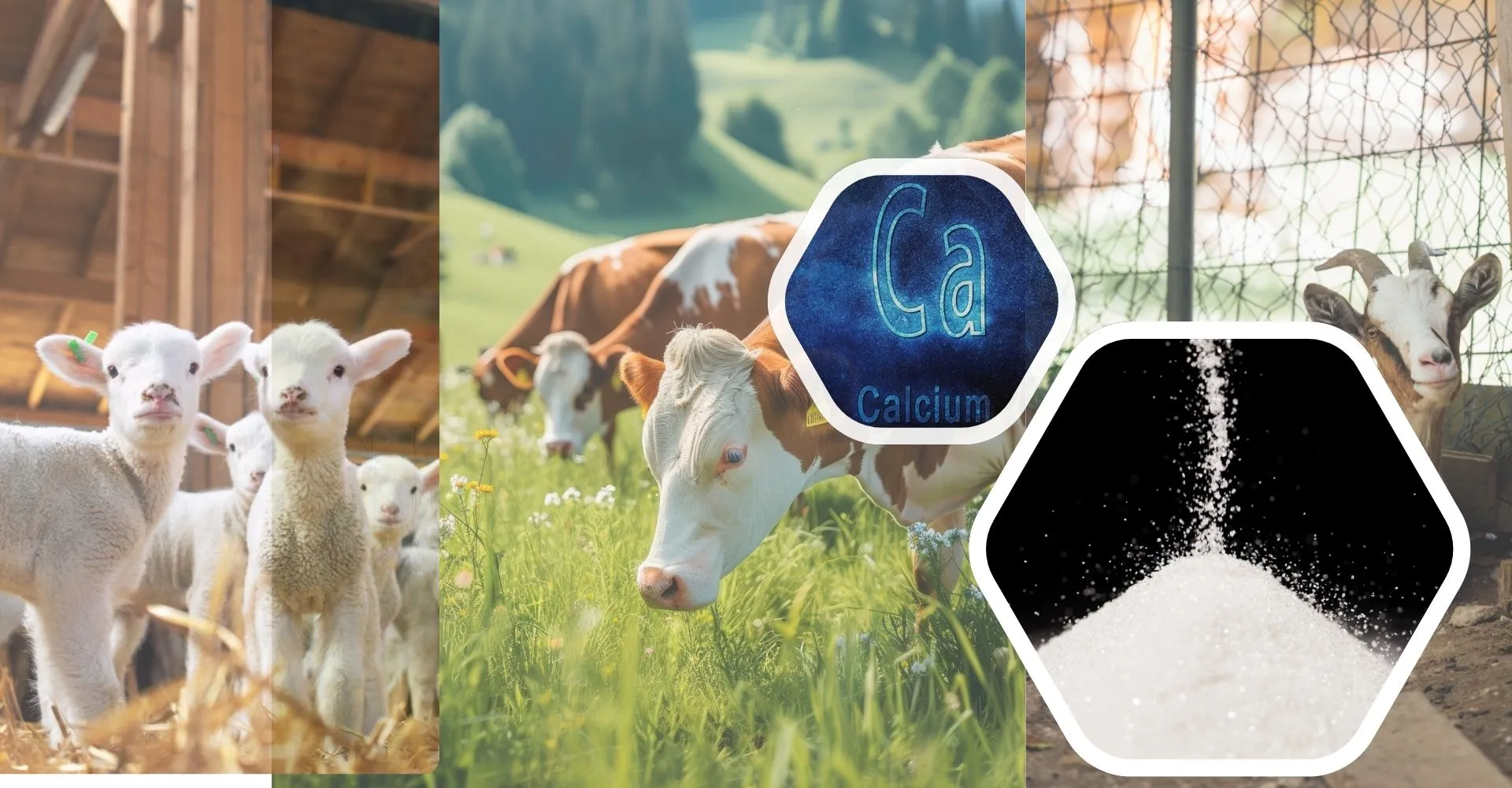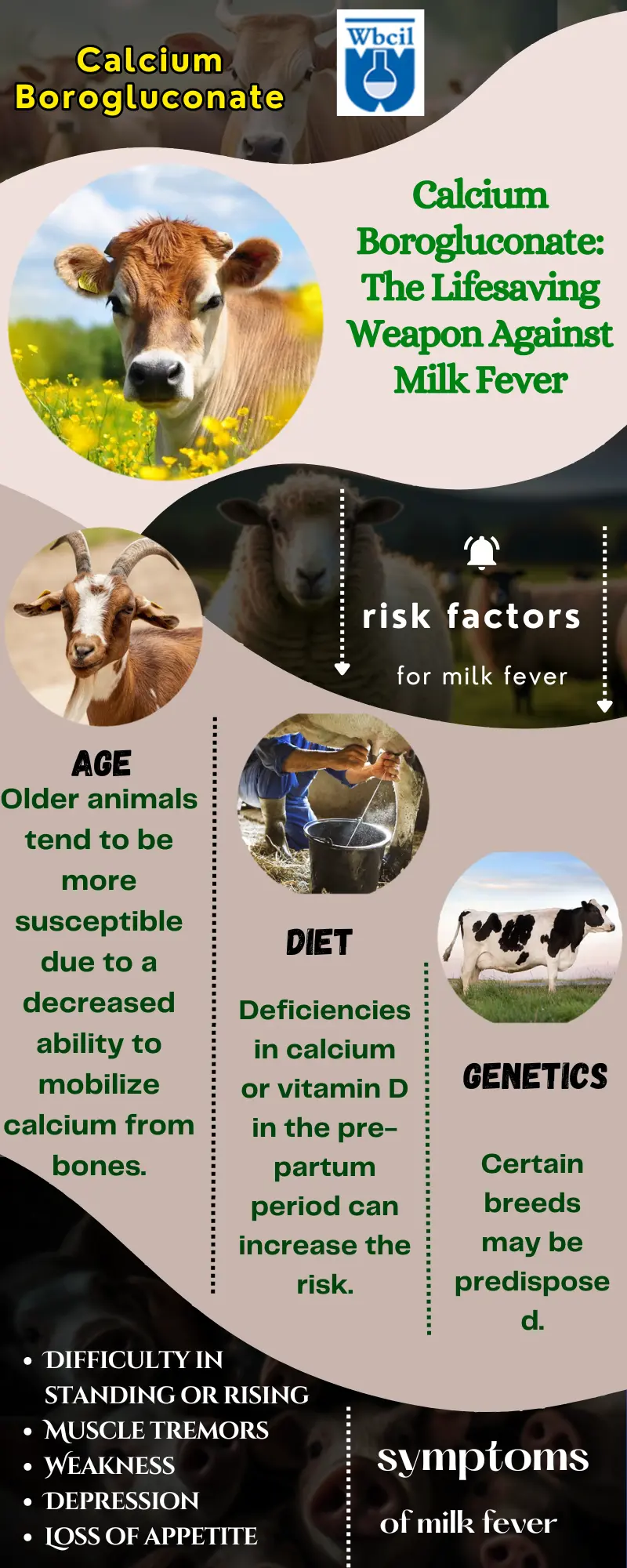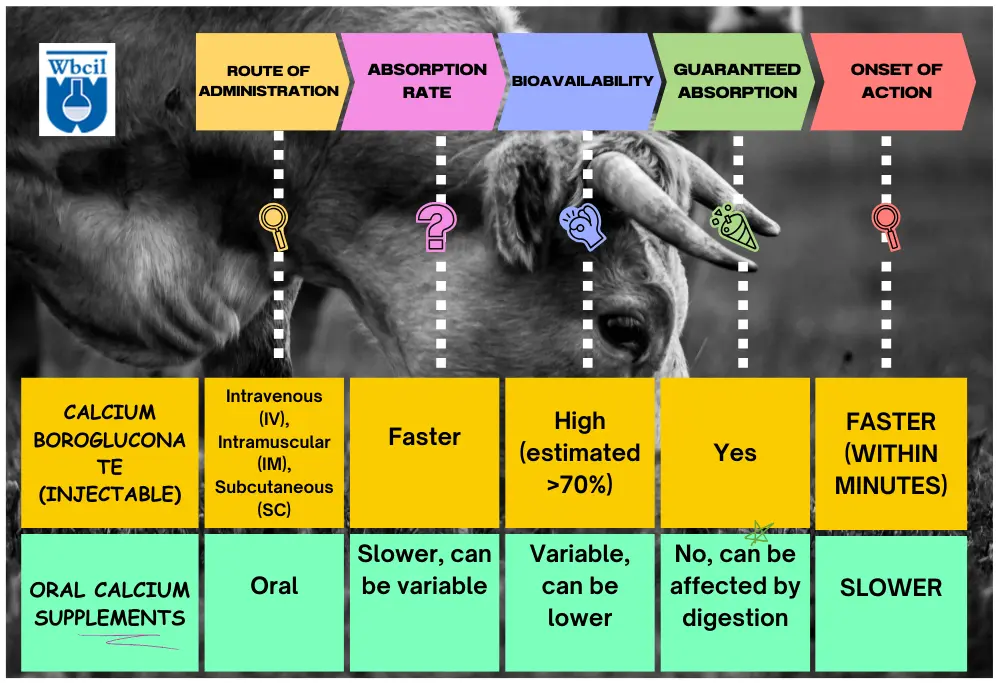The Mighty Molecule: How Calcium Borogluconate Saves the Day (and Night) for Animals
Have you ever heard of a superhero whose secret weapon is…calcium? Believe it or not, there’s a real-life molecule that acts as a lifesaver for cows, sheep, goats, and even pigs!
It’s called calcium borogluconate, and this seemingly simple molecule boasts a remarkable track record of saving the day (and night) for farm animals. In this article, we will cover calcium borogluconate uses/benefits, side effects, veterinary applications and more!
Milk Fever Mayhem: When Calcium Takes a Dive: Calcium borogluconate veterinary use:
Imagine a momma cow, just given birth, struggling to stand. Her muscles are weak, and she seems disoriented. This is milk fever, a common problem triggered by a sudden drop in blood calcium levels around calving. Milk production demands a lot of calcium, and sometimes, the cow’s body just can’t keep up 1.
Milk fever, also known as parturient paresis or hypocalcaemia, primarily affects dairy cows due to the significant calcium demands of milk production. However, the underlying cause – a sudden drop in blood calcium levels – can occur in other animals as well. Here are some examples:
- Beef Cattle: While less common than in dairy cows, beef cows can also experience milk fever, particularly high-producing breeds or those with multiple births.
- Ewes and Does: Similar to cows, sheep and goats can develop milk fever around lambing or kidding, especially if they are carrying multiple offspring or are older ewes/does.
- Sows: Though less frequent compared to ruminant animals, sows can also experience a drop-in blood calcium after farrowing (giving birth to piglets). This is particularly true for high-producing sows with large litters.
Calcium Borogluconate, the Speedy Calcium Supplier
This is where calcium borogluconate supplement swoops in like a calcium-charged knight. It’s a special type of calcium that gets injected directly into the bloodstream, bypassing the digestive system. This allows for a super-fast delivery of calcium, acting like an instant energy boost for the cow’s muscles and nerves.
calcium borogluconate preparation follows the reaction of calcium gluconate, a readily soluble calcium source, with boric acid, a boron-containing compound, in a precise 5:1 molar ratio within an aqueous solution 2. This process likely involves the formation of coordinate covalent bonds between the Lewis acidic boron atom in boric acid and the Lewis basic oxygen atoms of the gluconate ion

Benefits of Calcium Borogluconate
But how exactly does this calcium compound work its magic? Here’s the lowdown:
-
Calcium borogluconate mechanism of action:
Calcium Salt: Calcium borogluconate is a salt formed by the combination of calcium ions (Ca²⁺) and gluconate ions (C₆H₁₁O₇³⁻). However, on its own, calcium gluconate can be somewhat insoluble in water, potentially hindering its absorption 3.
- The Role of Borogluconate: This is where the borogluconate component comes into play. It acts as a chelating agent, essentially forming a complex with the calcium ions. This complex increases the overall solubility of the calcium salt in water.
-
Bypassing Digestion for Direct Delivery:
Unlike oral calcium supplements, which need to go through the digestive system for absorption, calcium borogluconate is administered directly into the bloodstream (intravenously) 4. This bypasses the digestive system altogether, allowing for:
- Faster Delivery: The calcium reaches the bloodstream much quicker compared to oral administration, leading to a faster response time in treating milk fever.
- Guaranteed Absorption: There’s no risk of the calcium being poorly absorbed or affected by digestive processes, ensuring a more predictable and reliable effect.
-
High Bioavailability:
Bioavailability: This refers to the proportion of a nutrient that gets absorbed from a supplement and becomes available for use by the body 5.
- Calcium Borogluconate: Research suggests that calcium borogluconate in cattle and otrher mentioned animals has a high bioavailability, meaning a significant portion of the administered calcium is absorbed into the bloodstream. Estimates suggest an absorption rate exceeding 70% in some cases.
- Rapid Action: The observed rapid improvement in symptoms after calcium borogluconate administration in milk fever indicates a relatively fast and efficient absorption process.
- Calcium borogluconate formulation presents a unique advantage. By combining calcium with gluconic acid and boric acid, it offers a highly soluble and bioavailable source of calcium compared to traditional calcium chloride. This enhanced solubility allows for higher dosing while minimizing the risk of precipitation within the body, a common cause of side effects like tissue irritation and cell death 6 7. Additionally, boric acid’s weak antibacterial properties may contribute to a reduced risk of infection at the injection site. This formulation offers a valuable tool for situations requiring rapid calcium repletion with a favorable safety profile.
-
Efficient Delivery Mechanism:
- Solubility: Calcium borogluconate contains a chelating agent, borogluconate, which enhances the solubility of calcium in water. This improved solubility allows for easier absorption compared to some other calcium salts 8.
- Direct Delivery: Bypassing the digestive system allows for direct delivery of calcium into the bloodstream, where it’s readily available to address the deficiency causing milk fever.
- The Power of Solubility: Calcium borogluconate is designed to be highly soluble, meaning it dissolves easily in water. This ensures the calcium gets into the bloodstream quickly and efficiently 9 10.
- Restoring Balance: With a quick boost of calcium, the cow’s blood levels are restored, allowing her muscles and nerves to function normally again. Within minutes, she can be back on her feet, and that’s a sight that makes any farmer happy!

Beyond Milk Fever: The Unsung Calcium borogluconate Benefits
While milk fever is calcium borogluconate’s main claim to fame, some potential indirect benefits exist:
- Improved Muscle Function: Calcium plays a crucial role in muscle contractions. While milk fever is a severe example, even mild calcium deficiencies could potentially impact muscle function and overall cow health.
- Enhanced Immune Response: Calcium is involved in various immune system functions. While a direct link hasn’t been established, maintaining proper calcium levels might contribute to a more robust immune system in cows, making them less susceptible to infections 11.
- Better Feed Utilization: Some studies suggest that calcium deficiencies can affect how efficiently cows utilize nutrients from their feed. Ensuring adequate calcium levels through treatment with calcium borogluconate could potentially improve feed utilization and overall cow health.
- Researchers are investigating the potential of calcium borogluconate pharmaceutical grade for sustained calcium delivery in 3D printed bone scaffolds, due to its unique combination of high biocompatibility, controlled calcium release, and excellent printability.
- Calcium borogluconate in dogs is a treatment for hypocalcemia and other conditions where elevating plasma calcium can bring physiological benefits to the animal.
Calcium borogluconate dosage
Calcium borogluconate dosage is crucial for effectively treating milk fever, a condition in cattle arising from a rapid drop in blood calcium levels around calving. While a general guideline exists (around 1 ml/kg body weight), the precise amount will vary depending on the severity of the case. To ensure optimal treatment and animal well-being, consulting a veterinarian is always recommended. They can determine the most appropriate calcium borogluconate dosage based on the individual animal’s needs [12]. For example, calcium borogluconate 23%, Calcium borogluconate 40 are solutions used in veterinary medicine to treat calcium deficiencies in animals.

Calcium borogluconate safety
Calcium borogluconate in cow offers a unique advantage in its safety profile compared to other injectable calcium sources. While some calcium salts can disrupt heart rhythm, calcium borogluconate’s gluconate component acts as a buffer, mitigating this risk. That is why calcium borogluconate for hypocalcemia is a favourite coice, particularly in animals with compromised cardiovascular health, where the potential for arrhythmias is heightened.
Calcium borogluconate for humans
While calcium borogluconate holds immense value in veterinary medicine for rapidly correcting low blood calcium (hypocalcemia) in livestock, particularly parturient paresis (milk fever) in cows, its use in humans is a different story. Unlike calcium gluconate, the preferred treatment for human hypocalcemia, calcium borogluconate’s breakdown releases boric acid, a compound with potential toxicity at high doses. This raises concerns about unintended boron accumulation and its side effects on the nervous system, especially in vulnerable populations like children and pregnant women. Furthermore, the slower conversion of borogluconate to bioavailable calcium compared to gluconate makes it less efficient in rapidly correcting a critical electrolyte imbalance in humans. Therefore, calcium borogluconate remains relegated to veterinary treatment, with safer and more effective options available for managing human calcium deficiencies.
Calcium borogluconate Storage
Calcium borogluconate injectible, a versatile compound with applications in medicine and veterinary science, presents unique storage considerations when housed in glass bottles. While glass offers excellent chemical inertness for the solution itself, its interaction with the dissolved calcium borogluconate market demand can be influenced by subtle factors. Research suggests that at high pH levels, the borogluconate component might slightly leach trace amounts of boron from the borosilicate glass matrix. This can be mitigated by storing the solution at slightly acidic pH or by using alternative glass compositions with lower boron content.
Comparative Efficacy of Calcium Borogluconate Vs. Other Calcium Supplements in Livestock Hypocalcemia Treatment
Calcium Acetate vs. Calcium Borogluconate: Calcium borogluconate is better absorbed and has a quicker effect in treating hypocalcemia in livestock compared to calcium acetate.
Calcium Bisglycinate vs. Calcium Borogluconate: Calcium borogluconate offers superior bioavailability and faster correction of calcium deficiencies than calcium bisglycinate.
Calcium Butyrate vs. Calcium Borogluconate: Calcium borogluconate is more effective in rapidly increasing blood calcium levels in livestock compared to calcium butyrate.
Calcium Pidolate vs. Calcium Borogluconate: Calcium borogluconate is preferred for its better solubility and quicker action in alleviating hypocalcemia in livestock compared to calcium pidolate.
Calcium D-Saccharate vs. Calcium Borogluconate: Calcium borogluconate is more efficient in raising blood calcium levels swiftly in livestock compared to calcium D-saccharate.
Calcium Citrate Malate vs. Calcium Borogluconate: Calcium borogluconate is favored for its rapid absorption and immediate impact on calcium deficiencies in livestock compared to calcium citrate malate.
Calcium Orotate vs. Calcium Borogluconate: Calcium borogluconate is more effective for acute hypocalcemia treatment in livestock due to its quick absorption compared to calcium orotate.
Calcium Aspartate vs. Calcium Borogluconate: Calcium borogluconate provides faster and more reliable increases in blood calcium levels in livestock compared to calcium aspartate.
Calcium Gluconate vs. Calcium Borogluconate: Calcium borogluconate offers better bioavailability and quicker therapeutic effects for livestock hypocalcemia than calcium gluconate.
Calcium Ascorbate vs. Calcium Borogluconate: Calcium borogluconate is preferred for its rapid correction of hypocalcemia in livestock compared to calcium ascorbate.
Conclusion
By understanding the power of calcium borogluconate for dairy industry and implementing preventive measures, farmers can ensure the health and well-being of their animals. So next time you see a cow happily grazing in the pasture, remember the tiny but mighty molecule that might have played a part in keeping her strong and healthy.
-
Milk fever: new approaches to treatment and control (Proceedings). August 1, 2011. Peter Constable, BVSc (Hon), MS, PhD, DACVIM, DACVN (Hon)
-
Braun U, Zulliger P, Liesegang A, Bleul U, Hässig M. Effect of intravenous calcium borogluconate and sodium phosphate in cows with parturient paresis. Vet Rec. 2009 Mar 7;164(10):296-9. doi: 10.1136/vr.164.10.296. PMID: 19270320. https://pubmed.ncbi.nlm.nih.gov/19270320/
-
National Center for Biotechnology Information. PubChem Compound Summary for CID 21969, Calcium borogluconate. 2010. https://pubchem.ncbi.nlm.nih.gov/compound/Calcium-borogluconate.
-
Parturient Paresis in Cows (Milk Fever, Hypocalcemia, Paresis Puerperalis, Parturient Apoplexy) By Garrett R. Oetzel, DVM, MS, Department of Medical Sciences, School of Veterinary Medicine, University of Wisconsin-Madison. https://www.sciencedirect.com/sdfe/pdf/download/eid/1-s2.0-S0372554517362053/first-page-pdf
-
Mohebbi-Fani, M., Azadnia, P. The effect of subcutaneous injection of calcium borogluconate on serum levels of calcium, phosphorus and magnesium in newly calved cows. Comp Clin Pathol21, 1647–1652 (2012). https://doi.org/10.1007/s00580-011-1342-0.
-
Fikadu, W. and Tegegne, D. and Abdela, N. and Ahmed, w. M. Milk Fever and its Economic Consequences in Dairy Cows: A Review, Institutional Repository Home, Jimma Institute of Technology, Biomedical Engineering https://repository.ju.edu.et/handle/123456789/1348
-
Amanlou, H., Eslamian Farsuni, N., & Amirabadi Farahani, T. (2012). Effect of Calcium Borogluconate Injection pre and Immediately Postpartum on Production Performance, Incidence of Metabolic Disorders and Situation of the Uterus After Calving in Cows Fed Anionic Diets. Iranian Journal of Animal Science Research, 4(3), -. doi: 10.22067/ijasr.v4i3.16260. https://ijasr.um.ac.ir/article_32281.html?lang=en
-
David J Lyons, Kelvin P Spann, Assay of Calcium Borogluconate Veterinary Medicines for Calcium Gluconate, Boric Acid, Phosphorus, and Magnesium by Using Inductively Coupled Plasma Emission Spectrometry, Journal of Association of Official Analytical Chemists, Volume 68, Issue 2, 1 March 1985, Pages 160–162, https://doi.org/10.1093/jaoac/68.2.160
-
Ji, L. and Hui, J. and Lin, P. and Rongfeng, W. and Yuling, H/ and Zhongshu, Z.; Nanjing Jiangsu Nongda Animal Pharmaceutical Co ltd; 2020. Worldwide. https://patents.google.com/patent/CN112106885A/en
-
Mohebbi-Fani, M., Azadnia, P. The effect of subcutaneous injection of calcium borogluconate on serum levels of calcium, phosphorus and magnesium in newly calved cows. Comp Clin Pathol21, 1647–1652 (2012). https://doi.org/10.1007/s00580-011-1342-0
-
CALCIUM BOROGLUCONATE By JA,MES STEW ART and HERBERT TAYLOR MacPHERSON M oredun Institute, Animal Diseases Research Association, Gilmerton, MidJ,othian. https://www.sciencedirect.com/sdfe/pdf/download/eid/1-s2.0-S0372554517362053/first-page-pdf
Calcium borogluconate is a calcium supplement used to treat hypocalcemia (low blood calcium levels) in animals such as cows, sheep, goats, and pigs. It is commonly used to manage milk fever in dairy cows.
Milk fever, or parturient paresis, is a condition in dairy cows characterized by a sudden drop in blood calcium levels around calving. Calcium borogluconate helps by quickly replenishing calcium levels in the bloodstream, restoring muscle and nerve function.
Calcium borogluconate is typically administered intravenously (IV) for rapid absorption and immediate effect. This method bypasses the digestive system, ensuring quick delivery of calcium.
While generally safe, potential side effects can include irritation at the injection site, and in rare cases, it can cause arrhythmias or other cardiovascular issues. It is essential to follow veterinary guidance for proper dosage and administration.
Yes, calcium borogluconate can be used for various livestock, including dairy and beef cattle, sheep, goats, and pigs. However, its use and dosage may vary depending on the species and individual animal needs.
Calcium borogluconate is highly soluble and has a high bioavailability, meaning it is quickly and efficiently absorbed into the bloodstream. It also poses a lower risk of tissue irritation compared to other calcium salts like calcium chloride.
Calcium borogluconate should be stored in a cool, dry place, away from direct sunlight. It is often stored in glass bottles, which are chemically inert, though slight leaching can occur at high pH levels.
In the case of an overdose, it is crucial to seek veterinary assistance immediately. Symptoms of overdose are cardiac arrhythmias, weakness, and muscle tremors.
Yes, calcium borogluconate can also be used to treat other conditions related to calcium deficiency, such as eclampsia in dogs, tetany in sheep and goats, and hypocalcemia in sows post-farrowing.

